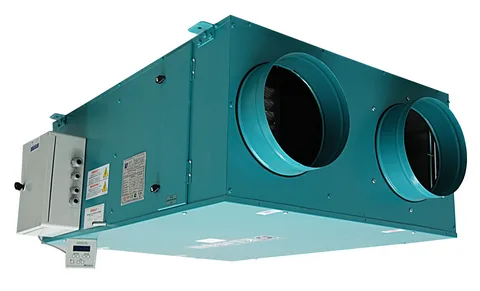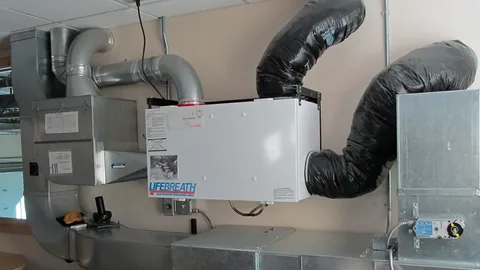As you spend more time indoors, the significance of maintaining a healthy indoor air quality cannot be overstated. Modern homes, whilst being more energy-efficient, often lack adequate ventilation, leading to a buildup of pollutants and moisture. Fortunately, an effective solution exists in heat ventilation, specifically those with heat recovery capabilities. These systems improve air quality and conserve energy, making them a smart choice for your health and the environment.
Understanding the Basics of Heat Drying Systems
Heat drying systems are pivotal in ensuring a continuous supply of fresh air into a building, while simultaneously removing stale, contaminated air to the exterior. These systems underpin maintaining an optimum indoor air environment by facilitating the relentless air exchange.
A quintessential hurdle with conventional ventilation mechanisms is their propensity for substantial thermal energy dissipation, which becomes particularly pronounced in colder settings. This inefficacy is mitigated by heat recovery ventilation (HRV) systems, which ingeniously marry the dual objectives of ventilating a premise and preserving the thermal energy inherent in the outgoing stale air.
The operational ethos of such systems revolves around minimizing energy loss, thereby fostering a balance between enhancing indoor air quality and conserving energy. As we delve further into the nuances of heat drying, it becomes clear that integrating heat recovery technology represents a significant leap forward in the quest for sustainable and healthy indoor environments.
The Mechanics of HRV
Central to operating a HRV system is its heat exchanger, a sophisticated device designed to facilitate the efficient thermal energy transfer. This critical component allows the outgoing, stale air to flow adjacent to the incoming, fresh air without the two streams mixing.
Through this process, the thermal energy from the exhausted air is captured and transferred to the cooler incoming air. This pre-warmed, fresh air is distributed throughout the premises, significantly diminishing the need for additional heating.
The effectiveness of this heat exchange process is instrumental in the HRV system’s ability to offer a sustainable solution for managing indoor air quality and thermal comfort. This innovative approach to ventilation exemplifies how advancements in technology can contribute to energy conservation and promoting healthier indoor environments.
 Benefits of Heat Ventilation System
Benefits of Heat Ventilation System
Investing in a heat ventilation system, especially those with heat recovery, yields multifaceted benefits pivotal for well-being and environmental stewardship. Primarily, it significantly enhances indoor air quality by facilitating the removal of pollutants, allergens, and excessive moisture, thereby reducing the risk of respiratory issues and creating a healthier living space.
Moreover, the inherent energy efficiency of HRV systems presents a notable reduction in heating costs. By recapturing and utilising the thermal energy from exhaust air, these systems diminish the reliance on traditional heating methods, leading to substantial energy savings.
Additionally, these systems contribute to maintaining an optimal humidity level, preventing the build-up of condensation and mould, which are detrimental to the home’s structure and its occupants’ health. This balance between ventilation and energy conservation underscores the intrinsic value of heat drying systems in fostering a sustainable, comfortable, and healthful living environment.
Key Features to Look For In the Best HRV System
When aspiring for an exemplary HRV system, it’s imperative to earmark several attributes that hallmark superior models. Foremost, thermal efficiency is a non-negotiable criterion, dictating the system’s adeptness at recapturing and reutilising heat from exhaust air, thus ensuring a noteworthy reduction in energy consumption. The system’s operation noise levels are also critical; optimal units blend seamlessly into the background, maintaining tranquillity within your living spaces.
Additionally, the ease with which one can maintain the system, particularly in filter replacement, is a practical aspect that cannot be overlooked. Look for systems featuring straightforward, user-friendly maintenance protocols. Programmable controls stand out as a desirable feature, offering the flexibility to tailor the system’s operation to your specific lifestyle and preferences, thus enhancing user experience and efficiency.
Lastly, sizing is of the essence; an adequately sized unit is fundamental in optimising the system’s efficacy and ensuring it meets the unique demands of your home environment without undue energy expenditure.
Installation Considerations and Best Practices
Installing a heat recovery ventilation (HRV) system requires meticulous planning and consideration of several key factors to ensure optimal performance and efficiency. Below are six essential subheadings to guide you through the process:
Professional Assessment
Contact a qualified HVAC professional to evaluate your home’s specific needs before installation. This includes assessing the unit size required based on your property’s dimensions and identifying the best locations for vents to maximise airflow and efficiency.
Compliance with Building Regulations
Ensure the chosen system meets all local building codes and regulations. This step is crucial to guarantee that the installation meets safety and environmental guidelines.
Strategic Ductwork Planning
The ductwork layout should facilitate smooth airflow and be as direct as possible to reduce energy losses. Consideration should also be given to placing intake and exhaust vents to avoid cross-contamination of fresh and stale air.
Insulation of Ducts
Properly insulating ducts is vital to prevent thermal loss and condensation, which can affect the system’s efficiency and the overall air quality within the home.
Electrical Requirements
Assess the electrical supply to ensure it can support the HRV system, considering any additional requirements for controls or sensors that form part of the system.
Adhering to these best practices can significantly enhance the installation process, ensuring your HRV system operates at its peak, providing a healthier indoor environment.
Environmental Impact of Heat Recovery and Ventilation
Adopting heat recovery and ventilation (HRV) systems is emblematic of a shift towards more environmentally responsible home heating and cooling practices. By harnessing the thermal energy from exhaust air that would otherwise be wasted, these systems significantly reduce the demand for conventional heating and cooling appliances, thus contributing to a lower household energy consumption profile.
This decrement in energy usage directly translates to a reduction in carbon emissions, a critical factor in the global effort to combat climate change. Furthermore, improving indoor air quality facilitated by HRV systems helps mitigate the health risks associated with air pollution, underscoring the dual benefit of enhancing human health while protecting the environment.
The ripple effect of widespread HRV system adoption could be substantial in energy conservation and reduction in greenhouse gas emissions, marking a pivotal step towards achieving sustainability goals and fostering a healthier planet for future generations.
Maintaining Your HRV System
To maintain the efficiency and longevity of your heat recovery ventilation (HRV) system, following a regular maintenance regime is essential. This includes regularly cleaning or replacing the system’s filters, typically recommended every three to six months, depending on usage and the manufacturer’s guidelines.
Keeping the filters clean ensures that air flows freely, preventing the system from overworking and reducing potential strain on its components. It is also vital to inspect ducts and vents periodically for any obstructions that could impede airflow, such as accumulated dust or debris.
An annual check-up by a qualified HVAC technician is highly recommended to assess the system’s overall health, address any technical issues, and perform specialized maintenance tasks. By dedicating time to these maintenance activities, you can significantly extend the functional lifespan of your HRV system, maintaining optimal air quality in your home and ensuring energy efficiency remains at its peak.
Optimising Your Home’s Airflow with Heat Recovery Ventilation System
Achieving optimal airflow within your home using a Heat recovery ventilation system requires strategic planning and thoughtful execution. First and foremost, the placement of air vents plays a crucial role; they should be positioned to ensure an even distribution of fresh air throughout the home whilst facilitating the efficient extraction of stale air.
Another vital aspect is balancing the system to ensure that the air being extracted is comparable to the supplied volume. An unbalanced system can lead to pressure issues within the home, affecting performance and comfort.
Additionally, integrating smart controls can significantly enhance the system’s efficiency. These controls can adjust ventilation rates based on occupancy, humidity levels, or specific user preferences, ensuring the system operates optimally under varying conditions and requirements.
Optimising Air Quality for Healthy Living
To further elevate the indoor air quality of your home, consider adopting practices that complement the operation of your heat recovery ventilation (HRV) system. Limiting products that emit volatile organic compounds (vows), such as certain aerosols, paints, and cleaning agents, can markedly reduce harmful pollutants in your living spaces.
Cooking can also introduce unwanted particles and moisture into the air, so ensuring your kitchen is well-ventilated by using extractor fans or opening windows is crucial. In areas of your home prone to dampness, employing dehumidifiers can assist in controlling moisture levels, thereby preventing mould growth and maintaining a healthier indoor climate.
Additionally, incorporating indoor plants can serve a dual purpose of enhancing your home’s aesthetics while contributing to the natural air purification. By integrating these practices with the functionality of an HRV system, you can achieve a superior level of air quality conducive to healthy living.
Expert Tips for Maintaining Best heat recovery ventilation system
A few expert guidelines are indispensable for ensuring the enduring performance of your Best heat recovery ventilation system. Foremost, vigilance in observing your system’s behavior is key. Listen for unusual noises or changes in performance, as these can be early indicators of a need for maintenance or repair.
Regularly inspecting the exterior vents is also crucial; blockages caused by leaves, debris, or snow can significantly impair functionality. While routine filter changes are essential, as highlighted previously, it’s equally important to use the correct type of filter as the manufacturer recommends to maintain optimal air quality and system efficiency.
Another professional recommendation is to have a detailed service by a certified HVAC technician at least once a year. This service should include thoroughly cleaning the heat exchanger, inspecting the fan and motor, and a system performance test to ensure everything is running as efficiently as possible.
FAQs
1. What Is The Difference Between HRV And ERV Systems?
HRV systems focus on transferring heat, whereas ERV (Energy Recovery Ventilation) systems also transfer moisture, making ergs more suitable for climates with high humidity.
2. How Often Should The Filters In My HRV System Be Replaced?
It’s recommended to replace or clean the filters every three to six months, depending on the manufacturer’s guidelines and the level of use.
3. Can Installing An HRV System Reduce My Energy Bills?
Yes, by reusing the heat from the exhaust air to warm incoming fresh air, HRV systems can reduce the need for additional heating, thereby lowering energy consumption and costs.
4. Can Retrofit An HRV System In An Older Home?
HRV systems can be installed in new and existing homes. However, the complexity and cost may vary depending on the house’s current ventilation infrastructure.
5. Do HRV Systems Also Cool The Air During Summer?
While primarily designed for heat recovery, some HRV systems can help reduce the incoming air temperature during warmer months by transferring heat from the incoming fresh air to the outgoing stale air.
Conclusion
HRV systems present a sophisticated and environmentally conscious solution for enhancing indoor air quality while conserving energy. By meticulously integrating such systems into the homes, they foster a healthier living environment through the constant influx of fresh, filtered air and contribute towards mitigating the carbon footprint. The benefits of installing an HRV system—from improved air quality and reduced energy costs to a more comfortable living space—are compelling. However, achieving these advantages requires careful consideration of system selection, installation, and maintenance.
| Other Good Articles to Read |
| Skank Blogs |
| Unreal Blogs |
| Tba Blogs |
| All City Forums |
| Dany Blogs |
| Refuge Blogs |
| The Music Blogs |
| Key Forums |
| The Big Blog Theory |
| Joe Blogs |
| Blogs 4 Me |
| Blogs Emon |
| Related Business Listings |
| Contact Directory |
| Local Business Profiles |

